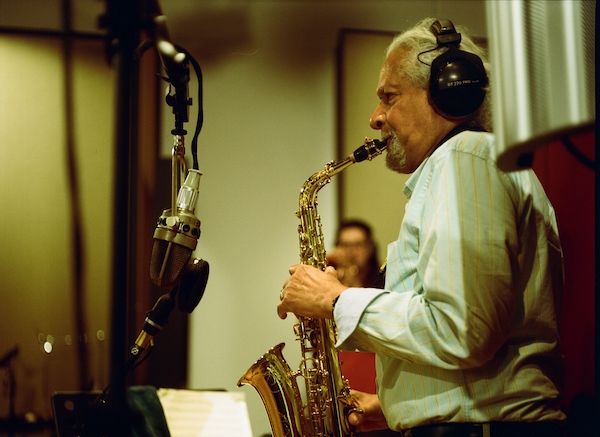Oct 28, 2025 10:47 AM
In Memoriam: Jack DeJohnette, 1942–2025
Jack DeJohnette, a bold and resourceful drummer and NEA Jazz Master who forged a unique vocabulary on the kit over his…

Gary Bartz collaborated with the UK-based ensemble Maisha for Gary Bartz & Maisha—Night Dreamer Direct-To-Disc Sessions.
(Photo: Elaine Groenestein)A 6-year-old Gary Bartz heard Charlie Parker playing on a Baltimore radio station in 1946. He’d never heard anything like it.
During the next five years, a young Bartz envisioned how he’d sound if he ever got his hands on a horn. Because he couldn’t play then, he listened. And he’s been listening ever since.
“Nothing’s more important than listening,” the saxophonist said recently. “By the time I got my horn, I knew how I wanted to sound—through the listening.”
Every era-defining sound he helped develop—from Art Blakey’s Soul Finger to Miles Davis’ Live-Evil—emerged from deep, persistent concentration. Now, almost 75 years after that auspicious moment in Baltimore, Bartz continues listening.
In May, he’ll release Gary Bartz & Maisha—Night Dreamer Direct-To-Disc Sessions, a recording co-led with the ensemble Maisha, which includes guitarist Shirley Tetteh and trumpeter Axel Kaner-Lindstrom. Bartz first partnered with the seven-piece UK band for the inaugural We Out Here Festival in 2019. Beyond their chemistry, he was struck by their depth of listening—a practice he considers a vanishing art.
“A lot of young musicians don’t listen as deeply as they should,” Bartz said. On tour with Maisha, he felt a kinship with ensemble members that hearkened back to the days when, he contends, artists placed a higher premium on loyalty and every musical legend had a working band. “All of Miles’ bands—but any great band, music of any type—they listen. As long as everybody’s listening, then they’re together.”
Developing a sound identity, Maisha never rushed the process. Members took time to understand their individual habits and what Bartz calls each member’s “aural fingerprint.”
“When we play, we try and connect together and make sure we’re all feeling it all in the same way,” said Maisha drummer and bandleader Jake Long. “We’ve built up this relationship where we really understand each other’s playing.”
When Bartz began touring with the ensemble, their chemistry and mutual admiration electrified audiences, and the direct-to-disc model for the partnership’s first release seemed inevitable.
“Gary listens so well,” Long continued. “He’s so aware of the music happening around him. That’s what’s so amazing about his playing.”
With no edits or post-production, the recording renders a performance snapshot of their time in the studio. “Warts and everything—go,” said Bartz. “There’s no fixing anything. It’s like doing a live record date.”
Beyond performance, the artists’ collaboration sought expansive conversations off the bandstand, as well, including the question of context. For the studio date, they collectively composed three originals and arranged two of Bartz’s enduring tunes, “Dr. Follows Dance” and “Uhuru Sasa.” On the recording, Bartz opted to lay out on vocals for the latter, because he felt his singing might need a bit of post-production attention—not because he intended to alter the impact of the civil rights-era composition.

Jack DeJohnette boasted a musical resume that was as long as it was fearsome.
Oct 28, 2025 10:47 AM
Jack DeJohnette, a bold and resourceful drummer and NEA Jazz Master who forged a unique vocabulary on the kit over his…

D’Angelo achieved commercial and critical success experimenting with a fusion of jazz, funk, soul, R&B and hip-hop.
Oct 14, 2025 1:47 PM
D’Angelo, a Grammy-winning R&B and neo-soul singer, guitarist and pianist who exerted a profound influence on 21st…

Kandace Springs channeled Shirley Horn’s deliberate phrasing and sublime self-accompaniment during her set at this year’s Pittsburgh International Jazz Festival.
Sep 30, 2025 12:28 PM
Janis Burley, the Pittsburgh International Jazz Festival’s founder and artistic director, did not, as might be…

Jim McNeely’s singular body of work had a profound and lasting influence on many of today’s top jazz composers in the U.S. and in Europe.
Oct 7, 2025 3:40 PM
Pianist Jim McNeely, one of the most distinguished large ensemble jazz composers of his generation, died Sept. 26 at…

Drummond was cherished by generations of mainstream jazz listeners and bandleaders for his authoritative tonal presence, a defining quality of his style most apparent when he played his instrument unamplified.
Nov 4, 2025 11:39 AM
Ray Drummond, a first-call bassist who appeared on hundreds of albums as a sideman for some of the top names in jazz…